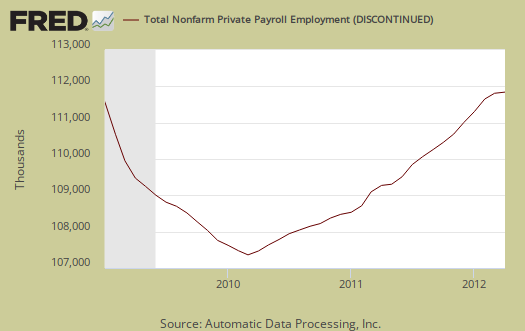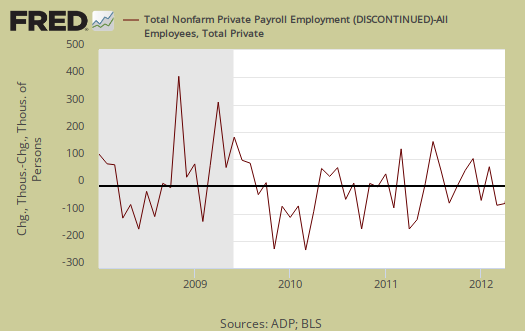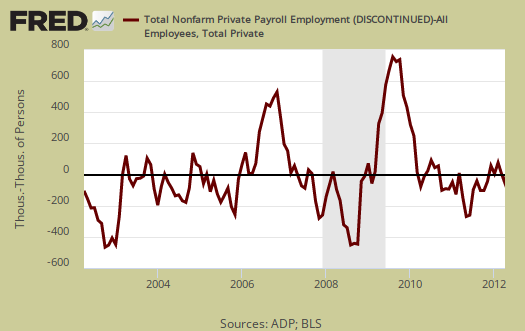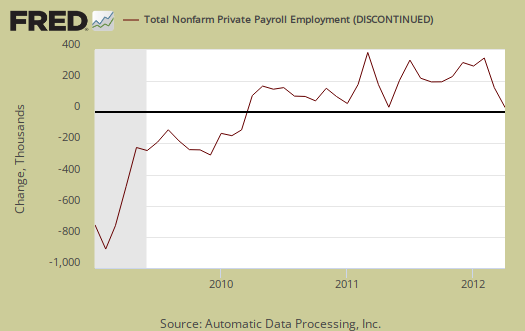ADP, released their proprietary private payrolls jobs report. This month ADP is reporting a gain of 119,000 private sector jobs in April. March 2012 was revised down by 8,000, from 209,000 to 201,000. In contrast, the BLS reported 121,000 private sector jobs for March 2012. Graphed below are the reported private sector jobs from ADP. This report does not include government, or public jobs. If ADP overstates jobs in comparison to the BLS, this is a terrible foreboding for the April official jobs report.

ADP's numbers claim the service sector gained 123,000 jobs while the goods sector lost 4,000 jobs. Manufacturing, part of the goods sector, lost 5,000 jobs and was the first job losses since September 2011. Construction also lost 5,000 jobs, and was the the first contraction in seven months. ADP's financial services jobs increased by 13,000 jobs, the 9th month in a row for private payroll increases for the financial sector.
This report, if it matches Friday's official unemployment report, would overall imply really bad news for jobs. Odds on there will be more government job losses and the U.S. needs about 100,000 jobs per month just to keep up with population growth.
ADP captures jobs by business size and this is worth looking at, especially due to it's relativity within the same report (and methods). In April:
Employment on large payrolls—those with 500 or more workers—increased 4,000 and employment on medium payrolls—those with 50 to 499 workers—rose 57,000 in April. Employment on small payrolls—those with up to 49 workers—rose 58,000 that same period. Of the 57,000 jobs created by medium-sized businesses, 8,000 jobs were created by the goods-producing sector and 49,000 jobs were created by the service-providing sector.
Below is the graph of ADP private sector job creation breakdown of large businesses (bright red), median business (blue) and small business (dark red). For large business jobs, the scale is on the right of the graph. Medium and Small businesses' scale is on the left.

Large business, who lobby Congress for their bad trade deals, more offshore outsourcing through foreign guest worker importation and labor arbitrage, are almost absent from job creation in terms of hiring Americans. Notice how large businesses cliff dove in 2008, shedding employees, and have not returned at all to pre-recession employment levels. This pattern actually starts just about the time offshore outsourcing and the China PNTR came into effect, year 2000. Small businesses, on the other hand, have increased employment. May I suggest that small businesses are not international, they are not signing offshore outsourcing contracts and moving jobs to India and China. Multinationals, on the other hand, the below decade trend line clearly shows these so called U.S. corporations have abandoned the U.S. worker, on whole.
There is a historic strong mismatch between ADP and the BLS jobs report, although recently the two are converging again recently. To date, the number of private nonfarm payroll jobs ADP reports versus what the BLS reports and on a month-to-month and even cumulative basis do not match. This monthly error is often large, especially when looking at small job growth overall (< 400,000 jobs per month) on a month to month basis. The monthly BLS jobs survey (CES) has a 100,000 payroll jobs overall margin of error.
The below graph shows shows how many private sector payroll jobs, each month, ADP was off by in comparison to what the BLS reported. This is a monthly graph, not cumulative. As we can see, it's rare where the two monthly reports get the exact same private payrolls growth numbers and March was off by 38,000 jobs. When the number is negative, that means the BLS reported a larger number of jobs than ADP did, when the graph bar is positive, it means ADP reported larger private payrolls. Again, these are private sector jobs which is different from the BLS headline number.

Below is the cumulative difference between what the ADP reports as the private nonfarm payroll jobs vs. the BLS (ADP minus BLS). This line shows the divergence, over time in number of nonfarm private payroll jobs reported between the two reports. The difference seems to be stabilizing around 400,000. This article is updated with the April BLS payrolls data.

While ADP notes a simple correlation of 0.95, well, a 5% error between monthly reported jobs numbers is an average, and we can see on some months the differences are quite large and around 2008, the difference started to hit about 900,000 jobs. That said, the reported job growth is so piss pour, statistically we're rolling around in the margin of error each month.
ADP does use the same seasonal adjustment as the BLS, but their other methodology and even sampling size are different, proprietary. That said, ADP has now put up some details of their methodology to explain the statistical differences between their estimate, the actual mathematics, vs. the BLS. This is new, and good ADP is disclosing their entire methodology so we may get more apples to apples comparisons of the two reports. The graph below is the monthly change of private jobs as reported by ADP.

Regardless of the statistical differences between ADP and the BLS, April's report indicates a return to poor job growth. Sorry folks, 100k job growth numbers does not mean the Gods are now shining upon us. More we're all simply used to seeing beyond belief, pathetic job growth numbers. We still have estimated 28 million people needing a job. Four Hundred thousand monthly job growth, on the other hand, would be something to sing hallelujah over.
Here is the March 2012 ADP private sector jobs report overview, only graphs revised.

no clearly monthly statistical pattern
There are some who try to correlate when the ADP and BLS private payrolls match by month. We just did a quick eyeball and there doesn't really appear to be a pattern, at least not for April. We do know it's rare for the two reports to match, although differences over 100k jobs are rarer. This makes sense considering the reports' margins of error.
Hi Robert
Robert, I have followed your postings here and at other blogs over several years. I generally find that you are almost always analytically sound and well-reasoned, with one glaring exception being the case of the consistently negative way in which you inject India into your commentary and in other things such as the current poll on your website. I hope that you will allow me to post responses in that and other regards on your site, and engage me in a debate should you disagree with what I post.
'May I suggest that small businesses are not international, they are not signing offshore outsourcing contracts and moving jobs to India and China'
In my view, we need to start moving away from that meme as it pertains to India, as ample data on trade (BLS, census.gov and others) clearly shows that India and the US are actually engaged in small and reasonably balanced trade in goods as well as services, with the latter covering offshore outsourcing contracts, etc. We have a real problem with China, with annual trade deficits in the $300 billion range, and thus the focus should be firmly kept on that front until those deficits are brought down (if at all that ever happens) substantially.
Besides, India is no longer the dominant global player that it was in IT/BPO and related service sectors. The Philippines, which is a tenth of India's population, has apparently taken the global lead as the destination of outsourced and call center services (or is close to doing so.) A number of other countries, such as other, smaller Asian countries, as well as those in Eurasia, South America, and other players are increasing their presence in that area, and therefore it is decidedly unfair to single out and scapegoat India for blame. To some degree, poor countries such as India and others getting a small piece of the global marketplace pie and striving to make their dirt poor masses less poor is a good thing as extends progress and economic justice to those countries that have been either left behind by development or turned destitute through European colonization (the latter being the case for India); progressively oriented activists and bloggers should keep this important thought in mind in the context of debating globalization context, IMO.
Thanks.
Gautam
that is false, your nationalism is showing
That's just purely false, as I amplify routinely. China just exceeded India as being the #1 offshore outsourcing destination.
That said, India by far is the worse offender in manipulating the U.S. immigration system. It is well documented, by the number of by nation statistics, India uses foreign guest worker Visas to take jobs from Americans and that is very, very wrong.
We all know the BEA counts work performed by foreign guest workers as domestic output, incorrectly. Additionally, the BLS counts foreign guest workers as U.S. workforce, employed, which is clearly wrong and skews, strongly, occupational categories which have been targeted by India's BPO industry. And yes, the Philippines has targeted health sector American jobs along with teaching jobs, also following the manipulation of the U.S. immigration system and abuse of foreign guest worker Visas.
Services maybe a small part of U.S. trade by comparison to the flood of Chinese imports, but in terms of U.S. labor, careers, stability, opportunity, they are multipliers in many cases of economic growth and India clearly is in the business of labor arbitrage. It's no small wonder how India's BPO industry is about 12% of their GDP and that's American jobs, stolen, as simple as that.
Yes, we're accurate and we're also extremely accurate when it comes to labor arbitrage.
If you want India to be strong economically, may I suggest coming up with your own products/goods, complete chains instead of relying on a labor arbitrage business model such as BPO and Indian owned bodyshops are doing in this country. It's obscene and even worse, in this country, outright discriminatory to have bodyshops loaded with nothing but Indian nationals, not a local U.S. worker in sight. You sure as hell don't see other large FCDCs operating like that in the United States, from Toyota to Honda to UBS to France Telecom, none import, by nationality, their workforce into the U.S. when doing business in the U.S. to the exclusion of U.S. workers.
You're even manipulating the statistics above to pimp for India. Somehow I don't think mangoes equates to offshore outsourcing and more importantly the massive, hidden deficits due to the refusal of U.S. statistical agencies to separate workers and services supplied by immigration status in this country.
Anyway, you're clearly just pimping for India and this site is very interested in the U.S. economy and the U.S. worker. We're not interested in promoting another nation's economic strategy, especially when that strategy comes at the expense of the American work force.